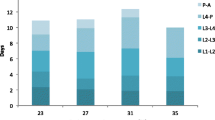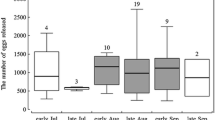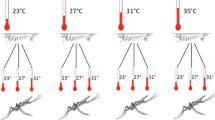Summary
We conducted experiments to assess the importance of winter cold and photoperiod as factors affecting the spatial and age distributions of overwintering larvae of the treehole mosquito Anopheles barberi. Larval dormancy in A. barberi was induced by photoperiods with 14.75 h of light or less per 24 h cycle. About 75% of the larvae entering dormancy were in the second instar regardless of photoperiod. Dormant second instar larvae survived freezing at-15° C for 24 h better than dormant third instar larvae. Larvae were more likely to survive freezing at-15° C in water from treeholes in which they were commonly found in nature than in water from treeholes in which they were unlikely to occur. Female oviposition was significantly higher into water from treeholes in which larvae were likely to be found than in either water from treeholes in which larvae were not commonly found or distilled water. These findings suggest that, in the northern part of its range, the distribution of A. barberi and the age structure of overwintering cohorts are influenced by extreme winter cold. The mechanisms responsible for the distribution of larvae and the overwintering age structure are, respectively, female oviposition behavior and larval photoperiodism.
Similar content being viewed by others
References
Ahmadi A, McClelland GAH (1983) Oviposition attractants of the western treehole mosquito, Aedes sierrensis. Mosq News 43:343–345
Baker FC (1935) The effect of photoperiodism on resting, treehole, mosquito larvae. Can Entomol 67:149–153
Beck SD (1980) Insect Photoperiodism, 2nd ed. Academic Press, New York
Bentley MD, McDaniel IN, Yatagai M, Lee HP, Maynard R (1979) p-Cresol: an oviposition attractant of Aedes triseriatus. Environ Entomol 8:206–209
Bradshaw WE (1973) Photoperiodism in Orthopodomyia signifera. Can J Zool 51:355–357
Bradshaw WE, Holzapfel CM (1984) Seasonal development of treehole mosquitoes (Diptera: Culicidae) and chaoborids in relation to weather and predation. J Med Entomol 21:366–378
Bradshaw WE, Holzapfel CM (1988) Drought and the organization of tree-hole mosquito communities. Oecologia 74:507–514
Copeland RS (1987a) Habitat segregation and life history patterns of the Culicidae of treeholes in northern Indiana. Ph. D. dissertation. University of Notre Dame, Notre Dame, Indiana
Copeland RS (1987b) Establishment of a free-mating colony of Anopheles barberi, with notes on developmental rates. J Am Mosq Cont Assn 3:502–503
Copeland RS, Craig GB Jr (1989) Cold hardiness of treehole mosquitoes in the Great Lakes region of the USA. Can J Zool (in press)
Danks HV (1971) Overwintering of some north temperate and arctic Chironomidae. II. Chironomid biology. Can Entomol 103:1875–1910
Danks HV (1978) Modes of seasonal adaptation in the insects. I. Winter survival. Can Entomol 110:1167–1205
Danks HV (1981) Arctic Arthropods. A Review of Systematics and Ecology with Particular Reference to the North American Fauna. Entomological Society of Canada. Ottawa
Holmquist C (1973) Some arctic limnology and the hibernation of invertebrates and some fishes in sub-zero temperatures. Arch Hydrobiol 72:49–70
Istock CA, Tanner K, Zimmer H (1983) Habitat selection by the pitcher-plant mosquito, Wyeomia smithii: behavioral and genetic aspects. In: Frank JH, Lounibos LP (eds) Phytotelmata: Terrestrial Plants as Hosts for Aquatic Insect Communities. Plexus Publ. Medford, New Jersey, pp 191–204
Jenkins DW, Carpenter SJ (1946) Ecology of the tree hole breeding mosquitoes of nearctic North America. Ecol Monogr 16:31–47
Kitching RL (1971) An ecological study of water-filled treeholes and their position in the woodland ecosystem. J Anim Ecol 40:281–302
Lounibos LP (1978) Mosquito breeding and oviposition stimulant in fruit husks. Ecol Entomol 3:299–304
Matheson R (1944) Handbook of the Mosquitoes of North America, 2nd ed. Hafner, New York
Mitchell L (1978) Biological investigations on five species of tree-hole breeding mosquitoes (Diptera: Culicidae). Masters thesis, Bowling Green University, Bowling Green, Ohio
Paulson SL (1984) Oviposition and egg diapause in field populations of Aedes triseriatus and Aedes hendersoni. Proc Ind Vector Cont Assn 8:1–8
Roubaud E, Colas-Belcour J (1932) Observations sur la biologie de l'Anopheles plumbeus. I. Le comportement larvaire. Bull Soc Path Exot 25:763–770
Shroyer DA, Craig GB Jr (1983) Egg diapause in Aedes triseriatus (Diptera: Culicidae): Geographic variation in photoperiodic response and factors influencing diapause termination. J Med Entomol 6:601–607
Snedecor GW, Cochran WG (1980) Statistical Methods, 7th ed. Iowa State University Press, Ames, Iowa
Snow WE (1949) The Arthropoda of wet tree holes. Ph. D. dissertation, Univ. Illinois, Urbana, Illinois
Sokal RR, Rohlf FJ (1981) Biometry, the Principles and Practice of Statistics in Biological Research, 2nd ed. W.H. Freeman and Co., San Francisco
Wilton DP (1968) Oviposition site selection by the treehole mosquito, Aedes triseriatus (Say). J Med Entomol 5:189–194
Wood DM, Dang PT, Ellis RA (1979) The Insects and Arachnids of Canada. Part 6. The Mosquitoes of Canada, Publication 1686, Research Branch Agriculture Canada, Ottawa
Zavortink TJ (1970) Mosquito studies (Diptera, Culicidae). XIX. The treehole Anopheles of the new world. Contrib Am Entomol Inst 5(2):1–35
Author information
Authors and Affiliations
Rights and permissions
About this article
Cite this article
Copeland, R.S., Craig, G.B. Winter cold influences the spatial and age distributions of the North American treehole mosquito Anopheles barberi . Oecologia 79, 287–292 (1989). https://doi.org/10.1007/BF00384306
Received:
Published:
Issue Date:
DOI: https://doi.org/10.1007/BF00384306




